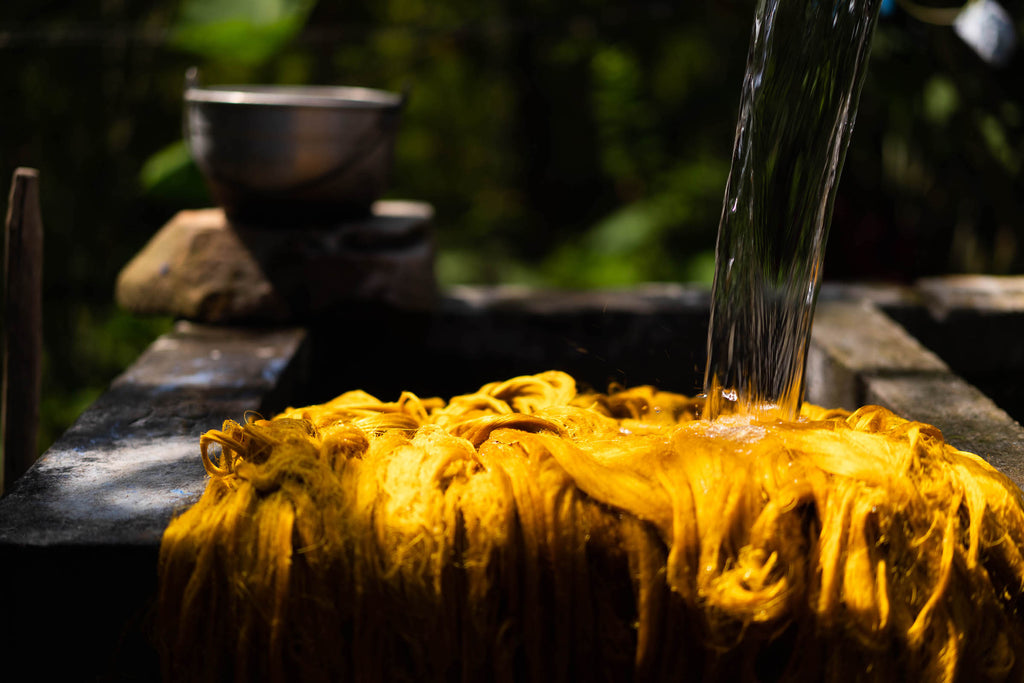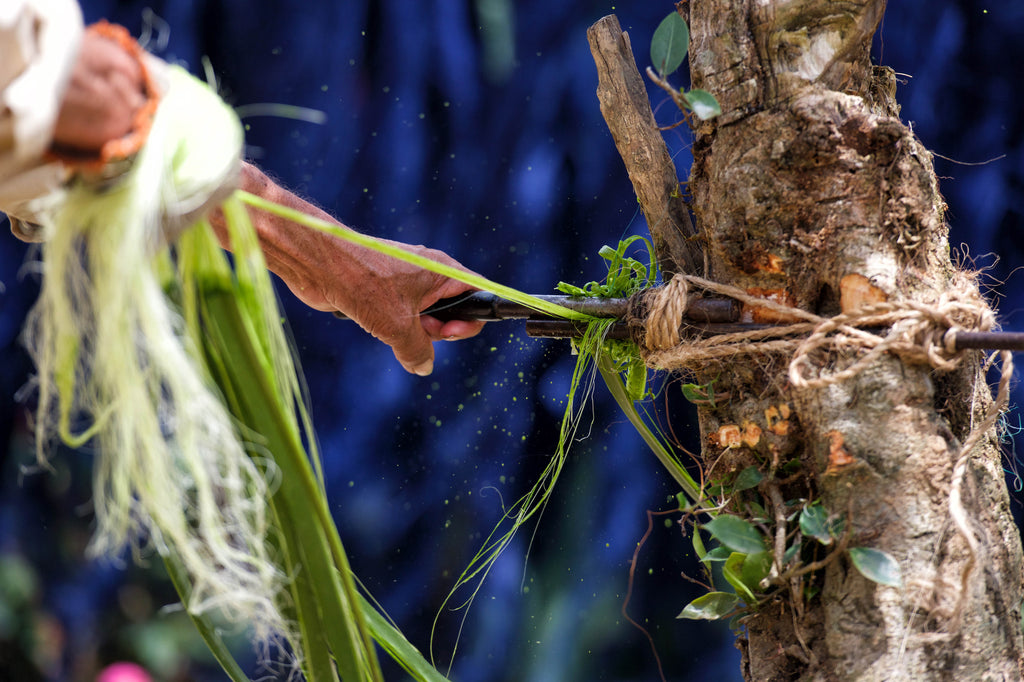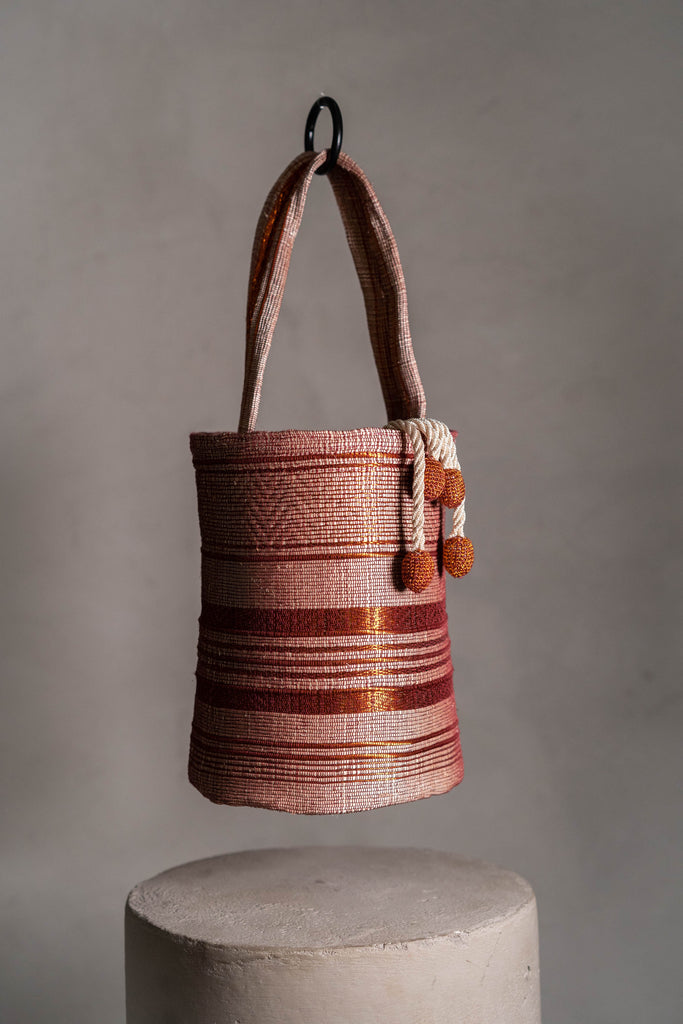Ethical Closet Series: Verdi

In this week's Ethical Closet Series we have the pleasure to present VERDI. Verdi is a Colombian textile studio that celebrates tradition to create unique homeware, fashion and art pieces by intertwining natural fibers with contemporary materials. From handwoven bags to unique rugs, every piece sustainably made by Verdi's artisans is absolutely beautiful and intricate, made with high quality natural materials.
Check out the IG Live talk with Tomás Vera, Founder and Creative Director of Verdi alongside his sister Cristina Vera, to learn more about this incredible brand and see a tour of their immersive showroom in Colombia.
UP: What is the history of Verdi?
V: Our story began in the Colombian mountains in 1995 with Carlos Vera Dieppa, a pioneer in Latin American textile design who, after meeting up with a skilled but rather skeptical coffee-sack weaver, developed a unique technique of intertwining local, natural threads and broadened a pair of looms to weave unusual fiber-rugs. He would later have the idea of adding metal to these rugs.
15 years later, after “Charlie’s” passing in 2010, his son Tomás and his daughter Cristina decided to honor his life and legacy by bringing back his craft. Through a renovated brand concept, both siblings reinstated an idea that even today, speaks of Colombia and its heartwarming traditions. They called this idea “VERDI” as an ode to their late father’s last names: VER-a DIeppa.

UP: What are the three pillars of sustainability that VERDI stands behind?
V: 1. SOCIAL RESPONSIBILITY
- Work with artisans in our workshop
- Work with farmers in Curití
2. ENVIRONMENTAL RESPONSIBILITY
- No deforestation
- Eco-friendly dye project
- Circularity
- Handmade
3. ACTIVATIONS AND INITIATIVES
UP: How have the communities of Curiti progressed since beginning to work with VERDI?
V: VERDI’s commitment to one exclusive farming community with steady, increasing demand has enabled a series of growth opportunities within its members. We’ve not only come to employ many of these people directly at our workshop in Bogotá, but we’ve also enhanced their work’s visibility hence increasing their connectivity with other key players in the industry.
On the other hand, a few years ago, VERDI started an eco-friendly dye project that would allow Curití farmers to dye fibers through a more sustainable, healthy process that could eventually be replicated throughout the industry, ultimately replacing the artisan’s traditional and at times even harmful ways. Not only would these dyes guarantee longer color durability for the fibers, but their usage would also ensure no environmental footprint and dyers’ welfare. Along with this particular project, which includes an educational campaign for these families, there are other plans focused on delivering wellbeing to the community (chimneys, production visibility, etc). The project’s completion and assertive evolution, however, depends on a series of factors that are currently beyond VERDI’s control, which is why we’ve been working on establishing partnerships with academic and governmental institutions that guarantee additional possibilities.

UP: The Corona Virus Pandemic has shaken up the world, how has VERDI helped the vulnerable communities in Colombia, through the Smiling Eyes Campaign?
V: The COVID-19 situation mad us rethink all of our internal structure and 2020s goals. VERDI decided to activate a temporal home-office initiative for our administrative and commercial teams and allowed artisans to weave from home. But protecting our workers is not enough, we feel the need to safeguard the health of our whole community since Colombia is facing a shortage of surgical masks. We have reinvented part of our operation to set up a production of SURGICAL MASKS to supply to those in need at no cost. We called to action other workshops and now SMILING EYES is an initiative that counts with the help of Pink Filosofy and Touché.
UP: What does Verdi’s Tree of life symbolize, and why is it so important to the brand's DNA?
V: Present in almost every world mythology, the “tree of life” not only embodies creation itself but also resonates with ancestry and our connection to the past. At VERDI, it symbolizes our Creative Director’s enduring bond with his late father, upon whose legacy he built the brand, and all whilst emphasizing on VERDI’s material identity through the tree’s copper-woven trunk and fique fiber threads in the foliage.
Fourteen people worked on the tree for almost five months weaving and twirling copper around the straw boning in the trunk, and later sewing non-spun and non-dyed fiber to its branches to create its leaf-like robustness. This mesmerizing piece brings back Colombian craft and reinterprets traditional techniques in a way that has never been done before.
UP: Can you walk us through the process of sustainable fiber extraction? When do the metals enter the process?
V: Only the outer leaves of the plant are extracted, thus allowing for the continued growth of crops and no deforestation. Once these leaves are pealed and its inner fiber extricated, the material is set out to dry under the sun. Once perfectly dry, the fiber is combed again, then dyed in several colors, and then spun into threads. Cones of colorful threads grace their way into our workshop to be woven by masterful hands. It is here, in most looms, where metal threads are finally intertwined with the fiber, depending on our design lab’s or our client’s decisions.

UP: How long does it take to make a Bucket bag? How many people are involved with the process?
V: The classic Colombian mochila is here reinvented by VERDI into a fiber & metal bucket bag. Carefully built by master weavers, each piece takes up to 4 days to be completed and intertwines silver-plated threads with plantain and fique fibers to be later enhanced with finely sourced details. Each bucket bag comes with interchangeable straps and an inner draw-string pouch.
UP: Unquestionably, VERDI products are a luxury to admire, how does the customer experience the textile and craftsmanship while visiting your showroom?
V: “The VERDI Showroom”, built in collaboration with local architecture firm Colette Studio, is nothing less than an immersion into cultural indulgence. Not only is it built from a heartwarming legacy of both family and traditional Colombian craftsmanship, but it also echoes our belief that exceptional, sustainable craft is today’s ultimate luxury. Resting behind contrasts in an unassuming and industrial neighborhood in the city, the exhibition space in our 400m2 warehouse is meant to be experienced in stages.
First, there’s the tunnel. The handwoven, 100% copper rug ceiling and the fiber floor in our entrance tunnel represent our brand’s core: the mix of fiber and metal; the traditional and the contemporary.
An initial sense of confinement when crossing the tunnel quickly gives way to an open, generous space that plays in with the textures and metal flashes in our homeware, fashion, and art pieces, all of which embrace our powerful brand symbol: VERDI’S Tree of Life. Hanging over visitors’ heads is this fantastic, almost Seussian tree; the centerpiece of The VERDI Showroom. Overlooking the tree and accessed only by an Amazonian-fiber spiral staircase, is a stylishly crafted mezzanine. From here, every single detail in the showroom -from the vertical garden and the cocktail bar in one end to the hanging textile installation in the other- may be taken in. This view, better served with a nice warm cup of Colombian coffee, is an invitation to design connoisseurs and design travelers worldwide, as it represents everything that our design studio seeks to be: an ode to Latin American and international design.
UP:. Do you foresee the future of fashion to follow a circular model? What initiatives is Verdi taking to reduce waste and Upcycle precious post-production trims?
V: a. HANDBAGS WASTE UPCYCLING - In the building of our handbags, we generate little fabric scraps that are now used to create thimbles for our weavers. They used to use masking tape to protect their fingers without losing mobility, generating lots of waste. Now with velvet and satin waste, we’ve created a sustainable and practical solution for our weavers.
b. RUGS WASTE UPCYCLING - When a rug is woven in our looms, we use some extra fiber to ensure the pattern is perfect, this extra fiber turns into waste when the rug is finished. We are now working on an up-cycling project to give a second life to this fiber and turn it into art pieces.
c. ACRYLIC PATTERN MOLD - To properly cut fabric for our handbags, weavers used cardboard pattern molds which were used 5-10 times before they became waste. To reduce this constant cardboard waste, we’ve created pattern molds in acrylic sheets.
d. OVERAL CIRCULARITY: seeking general circularity in its process, VERDI frequently uses fiber and textile waste to either craft new pieces and samples, or to decorate shelves at VERDI homes and headquarters. Our copper residues have even been donated for the assembly of important sculptures by local artists.
UP: Do you believe that there is a shift in consumers to value handmade sustainable luxury items for their home and their closets?
V: The “eco-friendly” feature has not only become trendy (in the best way possible), but it is increasingly being demanded by customers and usually even seen as inherent to “hand-made”. So, definitely consumer behaviors have been shifting in favor of a more sustainable approach to luxury. We believe that, when what is hand-made is truly unique and exceptional, it automatically and romantically becomes today’s ultimate luxury.
Website: verdi.com.co
Instagram: @verdidesign
